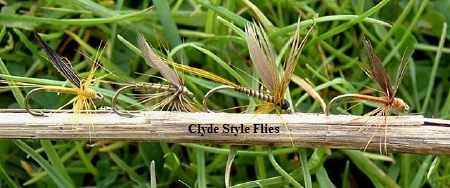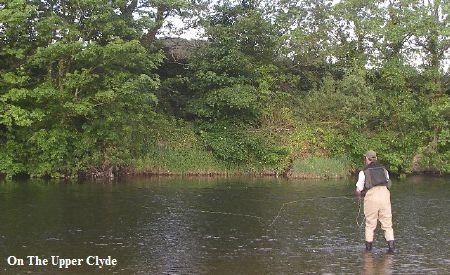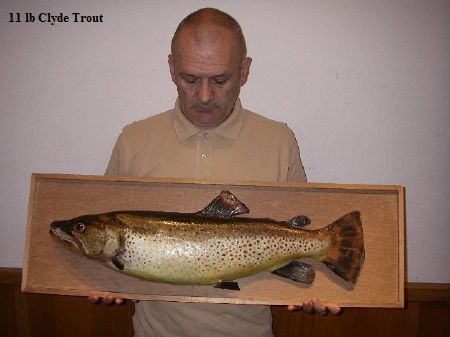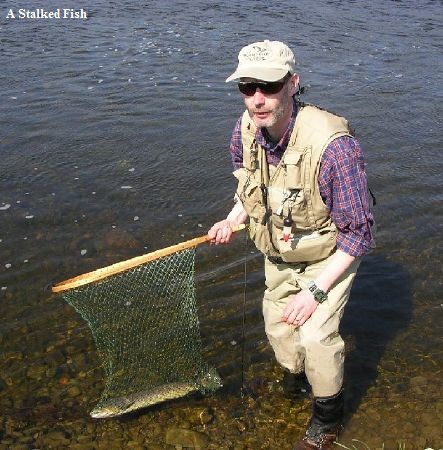Trout and Grayling in the Clyde
- Details
- Published on Sunday, 27 August 2006 12:08
- Written by Alex Laurie
 Although there are trout and grayling within Glasgow’s city boundary, it is only from Motherwell upstream that the river really appeals to the fly fisherman.
Although there are trout and grayling within Glasgow’s city boundary, it is only from Motherwell upstream that the river really appeals to the fly fisherman.
Not that the Clyde is exclusively reserved for the man who fishes ”the flee”. The Clyde fisher, historically speaking, has been a man who uses “stick bait” or cased caddis larva, as well as the spun natural minnow or maybe the “bairdy” or stone loach. The nymph of the stonefly, or “the gadger”, is another famed Clyde natural bait.
The old Clyde fishers were masters at tying their "flees" sparsely on small hooks. Trademarks of the Clyde style of wet fly include the unusual upright wing cocked at almost 90 degrees to the body. Hackles were very sparse, no more than one or two turns. Colours, too, were subtle and generally subdued, in keeping with the natural insects they were intended to represent. Pearsall's "Gossamer" silk was the tying silk of choice, the thicker "Naples" thread being too thick on the size 16 hooks used as standard on most of the patterns.
The casts were of horsehair and gut and could accommodate as many as five or six flies! I get quite enough tangles with the two flies I prefer to use when fishing wet flies! 
Grayling
Once upon a time the river held only brown trout in the upper reaches. In 1858 however, 160 young grayling were released after having been held for several months in the old stock pond at Abington. These thrived and the grayling fishing on the upper reaches was, at one time, excellent. These days the upper reaches seem to hold fewer but bigger grayling. During May of this year a huge fish of 4lbs was reported from the Crawford area. This was obviously exceptional, but there is a fair chance of landing a two pounder, anywhere from Motherwell to the headwaters. There definitely seem to be more grayling in the lower reaches these days though.
During the winter I used to love trotting a float using my old Aerial centrepin reel. These days I prefer to fish nymphs for the grayling. Although the Czech nymph method of fishing just a couple of feet of line out of the tip ring works in some runs, I prefer to use a yarn indicator or a Fish Pimp. Using one or two weighted nymphs and a shortish leader of around 9 to 12 feet, this set up can be fished at short to long distance and I think is more versatile than the short line Czech nymphing method. I use a #6 line for ease of casting when I know I will be using the deep nymph. By using line-mending techniques like stack mending, the indicator can be made to run drag free like a float, which is partly what it is in this method. This deep nymphing method is also how I fish for trout at the start of the season when nothing is showing at the surface.
Trout
When the trout start to show an interest in the first hatches of large dark olives at the beginning of the season, I will usually switch to dry fly. This is normally an F Fly with a flexifloss body or more recently an F Fly variant which is basically the same fly but tied using snowshoe hare fur rather than cul de canard, which can get gunged up with trout slime. Then again, this is a rare occurrence at the start of the season, unfortunately. Another fly, which I have been doing pretty well with, is a small, olive-bodied elk hair caddis. For emergers, I use small Klinkhamers or Bob Wyatt’s Snowshoe Hare Emerger, which is the same fly as his Deer Hair Emerger, only tied using snowshoe hare instead of deer hair.
Next main event is usually the march brown hatch, the bulk of which happens during April and peters out during early May. This usually provokes a short but furious rise. It is easy to get conned into thinking the trout are taking the duns. The splashy nature of the rises though is a give away that the trout are rocketing about here and there to take the nymphs just sub surface. For every trout taking duns there are many more targeting the nymphs. I, of course, get conned every year and fish dries when I should be fishing wets. Next year I intend fishing wet flies like the Partridge and Yellow and March Brown Spider as a first line of attack. This makes more sense when you consider that the nymphs can rise to the surface several times in the half-hour prior to actually emerging. No wonder the trout get keyed into the nymphs at the expense of the duns. They are available for a longer time.
 Around the same time as the march browns are on, the big stoneflies are hatching. The trout undoubtedly take the nymphs, which crawl out of the water to hatch. Although I have seen many adult stoneflies scuttling across the surface, I can not recall seeing a single one being taken, although I don’t doubt that this happens.
Around the same time as the march browns are on, the big stoneflies are hatching. The trout undoubtedly take the nymphs, which crawl out of the water to hatch. Although I have seen many adult stoneflies scuttling across the surface, I can not recall seeing a single one being taken, although I don’t doubt that this happens.
The sandfly appears around the 20th of May and has a short season. The trout can go crazy for this fly. I have always thought the sandfly to be the caseless caddis more commonly known as the “gravel bed”, but have recently heard it being described as a terrestrial.
The grannom also appears in May, and the yellow May dun starts to appear around the end of May and can last into July.
Although I have seen some fish concentrate on the yellow May dun, it is another fly which seems more attractive to the trout at the emerger stage rather than as an adult. In fact the grannom, yellow May dun, March brown and caddis in general all fall into this category, as far as I am concerned. Maybe I should be fishing wets more often than I do.
The rest of the season is pretty predictable as far as flies are concerned. Summer brings blue winged olives, light olives generally and sedges, as well as terrestrials like the cow dung, beetles and, occasionally, ants. One to look out for is the heather fly in August/September in the extreme upper reaches. A fall of these beasties can provoke total abandon on the part of the trout, but only occurs occasionally. Anything black and leggy will do, but we have used Oliver Edward’s “Foam Terrestrial” to good effect. It has enough mass to pitch into the usual howling downstreamer which prevails on the upper Clyde, which is where you will find the heather flies. Another fly worth trying at the back end is the Daddy Long Legs.
On the subject of wind, a west or southwest wind is upstream on the lower reaches up to Kirkfieldbank. Annoyingly, wind from the same direction blows downstream in the reaches from about Carstairs upstream. The east or north wind blows upstream in the upper reaches.
 Big Trout
Big Trout
April and May is the time when the river throws up most of its really big fish.
There have been at least three fish of over 10 lbs taken since the 1950s. The biggest of these was well over 15lbs and was caught at Abington during the mid 1970s. This fish was witnessed by a U.C.A.P.A. office bearer. Apparently the lucky captor arrived on the doorstep with the fish in a plastic bag for the U.C.A.P.A. man to see. When he lifted the bag he said, "My God, how many fish have you got in here?". To which came the reply, "Just the one".
Around twenty years before this, a 13lbs + fish was caught at exactly the same spot.
The third big fish weighed 11 lbs and was caught by Thomas Queen in the mid 70s from the dredgings at Lamington. It took a Rapala plug while he was after pike. I spoke to John Queen, the brother of the captor. He told me they were amazed when they saw the huge trout leaping on the end of the line instead of a pike as expected. He was good enough to let me photograph him holding a fibreglass cast that Thomas had made of the fish.
Although these fish are exceptional, there are usually 5lbs plus fish taken each season and some of these are taken on fly. Over the last two or three years I have seen fish which I reckon are around the 10lb mark. A couple of years ago an angler caught 2 fish on the Lamington water weighing 7lb 8oz and 5lb 8oz in a night session using fly. Not a bad night's work!
Spotting Fish
Big fish are pretty obviously easier to spot than smaller fish, so when the sun is shining and fish are unwilling to rise, this is the approach I prefer to take.
Polaroids are essential. I take advantage of high banks and wooded backdrops to check out likely areas and will often sit and watch from a vantage point rather than fishing the water blind when there is nothing rising. Any big fish spotted are cast to, if possible, and mentally noted for future reference.
 Sometimes it pays to work with a partner, as a team. The man who is casting is often out of position to see the fish, so his partner does the spotting and calls the shots. I can’t so far, claim any tremendous success doing this on the Clyde, but I am getting a picture of where a few big fish are. I did spot a fish for a mate and had the pleasure of watching the fish’s mouth open to sip in his wee nymph. I called “go” and he tightened into a fish of approaching 3lb. He had not seen the fish beforehand and he did not see any evidence of the take before I called. This is a really satisfying way to catch fish, both for the angler and for the spotter, who gets a kick out of helping his mate and learns something of trout behaviour in the process.
Sometimes it pays to work with a partner, as a team. The man who is casting is often out of position to see the fish, so his partner does the spotting and calls the shots. I can’t so far, claim any tremendous success doing this on the Clyde, but I am getting a picture of where a few big fish are. I did spot a fish for a mate and had the pleasure of watching the fish’s mouth open to sip in his wee nymph. I called “go” and he tightened into a fish of approaching 3lb. He had not seen the fish beforehand and he did not see any evidence of the take before I called. This is a really satisfying way to catch fish, both for the angler and for the spotter, who gets a kick out of helping his mate and learns something of trout behaviour in the process.
Of course, spotting is not always possible and if no fish are rising it is necessary to fish the water blind. I always work upstream and will often concentrate on the pocket water and the fast water at the run into a pool as I seem to take more fish from this type of water when fishing blind. Usually I will use a nymph like a PTN or a similar fly I tie using UTC wire as the abdomen, which gets a lot of weight in a small package. These are fished under a small yarn indicator, or sometimes under something buoyant and visible like an elk hair caddis, used as an indicator cum dry fly.
Permits
Almost the whole of the river from Motherwell upstream is in the hands of three clubs, as far as trout fishing is concerned. They all offer day tickets for the price of two or three pints.
The United Clyde Angling Protective Association offers tickets at the following prices.
Adult Annual £26.00. Day Permit £7.50
Juvenile Annual Permit £8.50
Grayling Season Permit was £12.50 last winter valid from 7th October until
14th March.
The U.C.A.P.A. stretches extend from Motherwell bridge up to Stonebyres at Kirkfieldbank, from Easter Sills Farm at Carstairs Junction to Thankerton Bridge and lastly, from Roberton Burn up to the headwaters. It should be noted that fishing upstream of Telford Bridge above Crawford is out of bounds at present. This is due in part to a dispute over access and also because this stretch is subject to trapping of American signal crayfish, which infest the river up here. U.C.A.P.A. tickets can be had from various outlets including The Anglers Emporium in Hamilton.
The Hozier Angling Club has the fishing from Stonebyres up to Easter Sills Farm. Their day permit is around £5 and is available from the Hyndford Bridge Nursery, between Lanark and Biggar.
The Lamington & District Angling Association leases the fishing between Thankerton bridge and Roberton Burn. Day tickets are £6 for trout and £3 for grayling and a season costs £30. Tickets can be had from various sources in the Biggar area including the Esso garage and also from The Anglers Emporium in Hamilton.
Alex Laurie , now into his 50th year, has been fishing since the tender age of 12. He used to do a lot of coarse fishing and, until last year, held the Scottish bream record with a 10lb 4oz fish. Alex has fished all over the world, including Alberta Canada and has cast a fly in New Zealand for 5 out of the last 6 years. He prefers rivers, but loves our wild highland lochs too.
Alex works in property management, says he is a frustrated blues guitarist and lives with his very understanding partner Linda in Cambuslang near Glasgow.

